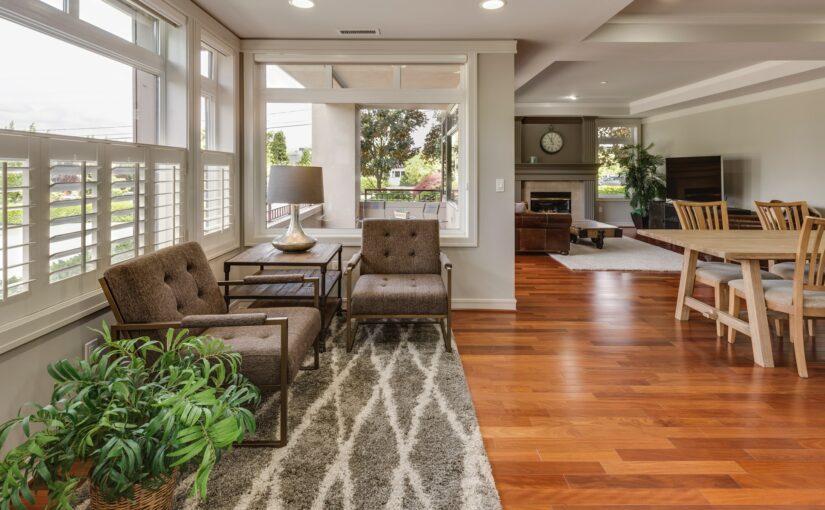The open concept floor plan has been around for many years, since the 90s. To this day it remains popular a popular house improvement among many homeowners, thanks to its flexibility and aesthetic appeal. One of the things that draw people to the open floor plan is the fact that many people feel rather confined by hard divisions in houses. In this article, we will outline a few considerations to make if you want to remodel your house for an open floor plan.
What are the pros and cons of an open concept floor plan?
Despite their appeal, open concept floor plans represent a great departure from regular structured layouts. They aren’t for everyone. Before you commit to remodeling for this floor plan, consider weighing the pros against the cons.
Pros of open floor plans
- It’s flexible – With an open floor plan, there are no limits to how you can arrange your home. With some creativity and planning, you can have a great setup that allows you to cook, watch TV, and supervise the kids at the same time. You can also switch up the layout as often as you like when you feel bored with the current layout.
- It offers value – The value of your home, both perceived and actual, will go up when you switch to an open floor plan. Homes with such layouts tend to attract more interested buyers than others. In some areas, they even often sell for more than the asking price.
- It allows for the smooth flow of traffic – An open floor plan optimizes circulation throughout your house. This optimization will then improve workflow in areas where lots of people gather and work, like the kitchen and living room.
- It optimizes for natural light – Walls can steal a lot of natural light from the house. When you take them down, the natural light flows between different rooms more easily and the atmosphere greatly improves.
- Family bonds better – When you take down the physical ones, the metaphorical borders between family members fall with them. Open floor plans encourage household members to be closer to and spend time with each other, which improves their bonds.
Cons
- It costs a lot – Converting a home to an open concept floor plan costs a lot of money, thanks to the taking down of walls and all the necessary structural adjustments. You will most likely have to work with engineers and architects besides a contractor.
- Energy costs will go up – Big open spaces can easily rack up HVAC costs since they cost more to cool and heat. These costs will be felt most strongly during extreme seasons, like summer and winter. If you’re going to commit to an open floor plan, expect to pay more in utilities.
- The atmosphere gets busier – When you take the walls down, you make it easier for people to engage in more activities in the space. When these activities overlap the atmosphere can feel busy and the house can easily get disorganized, even cluttered. For household members that like their private space, this can be a problem.
- The house gets noisier – This ties in to a busy atmosphere. With more activity noise levels will rise, which can be intolerable.
- It’s harder to demarcate sections – While the whole point of an open floor plan is to do away with hard divisions, you might still want clearly identifiable sections in your house. It’s harder to do that with an open floor plan, especially if your space is large. It’s also harder to designate storage space.
Is an open floor plan right for your house?
Despite their allure, open floor plans are not for every home. Many may need steel beams installed to strengthen their structure so that removing the walls doesn’t damage their integrity. To determine if an open floor plan is suitable for your house, you will need to work with a skilled and experienced structural engineer. They will assess your home’s structure to determine if your desired layout is possible. If it isn’t, a talented engineer should be able to help you figure out a way around the issue. You may expand corridors or even extend the home and have the desired layout in the extension.
5 step to converting to an open floor plan
Once you are clear about your desired floor plan, you can start working on the project. Such renovations need you to work with a team of general contractors, architects, and structural engineers. Below are the steps to take:
1. Create layouts and have your home assessed
You first need to get a structural engineer to check out your home and assess the existing structure and layout. They will then use their assessment to create the right kind of building plan for your vision. Once that is done, get a designer or architect to help with the creation of plans and layouts. They will supplement the engineer’s work by adding the latest design trends to your home.
2. Find a general contractor and get building plans
With your plans ready, seek out a skilled and experienced general contractor to do the actual work on your project. The contractor will also help you with getting building permits for the renovations, especially the ones for making structural changes to the house. They will also help with inspections to ensure all works comply with building codes.
3. The demolition phase
Once you have all the permits, the demolition phase comes next. The general contractor should take care of this, ensuring load-bearing walls were taken down and structural beams put up to maintain your home’s structural integrity.
4. The renovation phase
Once the structural reinforcement has been carried out, the renovation can now happen. This is where flooring, drywall, paint, cabinets, and other elements are installed.
5. Finishing touches
When the hard work has been done, you can select finishings like doorknobs, fixtures, and other little details to make your vision a reality.
Conclusion
Renovating to an open floor plan can feel daunting, and will certainly take work, but it isn’t impossible. With the right contractor and a razor-sharp vision, it should be possible to make it work.
Author Bio

Leon Collier is a blogger and academic writer from the UK who has vast experience working with SuperiorPapers, an admission essay writing service. He loves to take on every challenge thrown at him and has the ability to deliver outstanding work regularly. When he’s not busy writing, he loves reading books and playing tabletop games with his friends. Follow him on Twitter @LeonCollier12.
Photo by Francesca Tosolini on Unsplash

The social benefits of an open-floor house plan that you talked about were really interesting to read. Having a house that can allow for better family bonding and social interaction could definitely help us enjoy the holidays better when we invite our relatives over. Once I find a floor plan expert that can help me with some remodeling, I’ll tell them that this is what I’m after.